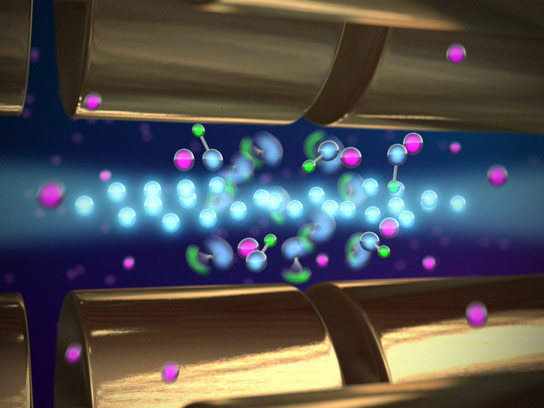Purification of nanofullerenes by column chromatography for the manufacture of nanoelectronic tools and equipment (PhD in Nano-Microelectronics)
Researcher and author: Dr. ( Afshin Rashid)
Note: Purification of nanofullers is usually performed by high performance column chromatography. Also on a smaller scale , sublimation can be used to produce high-purity solvent-free fullerenes. Fullerenes are soot-like solids, dark in color, and in some cases bright.
The solubility of fullerenes in hydrocarbon solvents is usually low, but in aromatic nanomolecule solvents it is high, and in nanostructured compounds the larger fullerenes are less soluble than the smaller fullerenes. These nanostructured compounds were first obtained by electric discharge. The exact mechanism for the formation of fullerenes is not known, but they appear to be produced during the formation of carbon plasma. Purification of fullerenes is usually performed by high performance column chromatography. Also on a smaller scale , sublimation can be used to produce high-purity solvent-free fullerenes. Fullerenes are soot-like solids, dark in color, and in some cases bright. Solubility of fullerenes in solvents Hydrocarbons are usually insignificant but are high in aromatic nanomolecule solvents and in solids nanostructures larger fullerenes are less soluble than smaller fullerenes. Buckyballs can, if compressed, return to their original shape and rotate at an astonishing rate. Fullerenes are the particles that make up buckwheats in electrically conductive nanomaterials. Buckyballs and fullerenes are among the materials on which many nanomaterials are based. One of the most important and unique properties of fullerenes is their ability to hold atoms or small molecules inside a carbon cage. The importance of spatial and electronic parameters related to cage structure such as fullerene in the factors of this importance of nanostructures and The stability of these compounds. The optical properties, ionization and electron-seeking energies, and the relative stability of the various fluorine multiplicities are very influential in the amplification of nano-electronic devices.
Nanofullerenes can be defined as materials that have at least one external dimension of 1 to 100 nanometers. And the particle size of at least half of the particles in the number size distribution of 100 nm or less. In nano-electronics , nano fullerene can occur naturally, as byproducts of combustion reactions occur or are targeted by engineering Perform a specific function to be produced. These materials can have different physical and chemical properties than their bulk prototypes. The Nano fullerenes are in response to an applied electrical voltage used in combination to bend. The use of nano-fullerenes is common in a wide range of industries and consumer products. In nanoscience, the structure of a substance determines the relationship between the atoms, ions, and molecules that make it up. To understand the structure of materials, one must first understand the type of bonds between atoms and ions . Chemical bonds determine how bonds between atoms and ions are made. Therefore, differences in the type of connections can be seen in the properties of these links.
Conclusion :
Purification of nanofullers is usually performed by high performance column chromatography. Also on a smaller scale , sublimation can be used to produce high-purity solvent-free fullerenes. Fullerenes are soot-like solids, dark in color, and in some cases bright.
Researcher and author: Dr. ( Afshin Rashid)
PhD in Nano-Microelectronics




